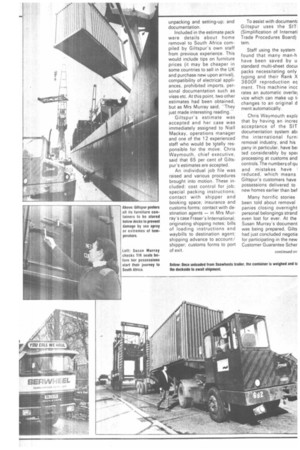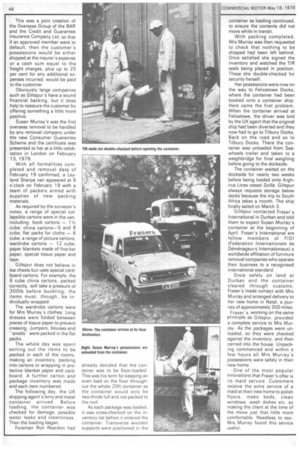Take the trauma from home moves
Page 46

Page 47

Page 48

If you've noticed an error in this article please click here to report it so we can fix it.
Brian Chalmers-Hunt describes the experiences of the first customer for BAR's Customer Guarantee Scheme for an overseas move
MOVING HOUSE contents is a traumatic experience. After the problems of finding a new home, battling with estate agents and solicitors over all the legal formalities and, probably, trying to settle in a new job as well, the final hurdle, the move itself, can be the last straw.
The usual course of action is to seek the services of a removal company through the Yellow Pages, local press or by personal recommendation. The first com pany to react to the request gets the job and — well, the results can be the centre of conversation for years to come.
The very thought of an international home move would invite the possibility of a ner vous breakdown for many people, but this was not the case for newly married Susan Murray, who was leaving her home near Chippenham, Wilts, to emigrate to Natal, South Africa.
Mrs Murray has considerable business experience behind her and knew of BAR(British Association of Removers), so she sought out the names of three international 'removal companies who were members. These were obtained from friends who had already completed successful international moves.
Giltspur International Moving, a member company of Giltspur Bullens Freight Ltd, was recommended as one possibility. Susan Murray con tacted Giltspur's sales depart ment and at this point its system came into operation. Within a week Mrs Murray received an information pack about the company and had an appointment booked for the surveyor to call and see her.
During his visit, international surveyor Barry Burton took a full brief of his client's wishes and noted any special requirements — in this case, valuable antiques to be packed, and only part of the home to be shipped abroad.
He then accurately estimated the volume of the shipment in cubic feet and converted to a ratio of lbs weight to Cu ft. This took into account special pack ing for oil paintings and antique furniture. Experience has shown him that on a typical home move, which includes furniture, bedding, glass, china and cloths, the average density is approximately 6:5Ib per cuft.
Mr Burton went on to explain to Mrs Murray what Giltspur, from its side, required. For example, Giltspur prefers, for insurance and customs reasons, to pack everything. At the end of a typical three to four-hour home visit, the surveyor had put Susan Murray completely at ease and left her in no doubt that the job would be in capable hands.
Two days later Mrs Murray had received a comprehensive estimate from the operations department. This included details of the charges from the three service operations departments origin. freight and destination) that would handle her possessions.
According to the estimate, origin services included: the experience of full-time professional staff; transportation to and from residence to docks; new packing materials; new wooden cases; documentation and administration.
Freight services included: export handling and terminal charge and transport by ocean and overland.
Documentation and destination services: customs clearance; collection from point of arrival; delivery to residence; unpacking and setting-up; and documentation.
Included in the estimate pack were details about home removal to South Africa compiled by Giltspurs own staff from previous experience. This would include tips on furniture prices (it may be cheaper in some countries to sell in the UK and purchase new upon arrival), compatibility of electrical appliances, prohibited imports, personal documentation such as visas etc. At this point, two other estimates had been obtained, but as Mrs Murray said, They just made interesting reading."' Giltspurs estimate was accepted and her case was immediately assigned to Niall Mackay, operations manager and one of the 12 experienced staff who would be t9tally responsible for the move. Chris Waymouth, chief executive, said that 65 per cent of Giltspurs estimates are accepted.
An individual job file was raised and various procedures brought into motion. These included: cost control for job; special packing instructions; contact with shipper and booking space; insurance and customs forms; contact with destination agents — in Mrs Murray's case Fraser's International; originating shipping notes; bills of loading instructions and waybills to destination agent; shipping advance to account/ shipper; customs forms to port of exit. To assist with document Giltspur uses the SIT (Simplification of Internati Trade Procedures Board) tern.
Staff using the system found that many man-h have been saved by u standard multi-sheet docui packs necessitating only typing and their Rank X 3600F reproduction ec ment. This machine incc rates an automatic overla) vice which can make up t1 changes to an original d ment automatically.
Chris Waymouth explE that by having an increE acceptance of the SIT documentation system abl the international furn: removal industry, and his pany in particular, have be ted considerably by spei processing at customs and controls. The numbers of qu and mistakes have reduced, which means Giltspurs customers have possessions delivered to new homes earlier than bef Many horrific stories been told about removal panies closing overnight personal belongings strand even lost for ever. At the Susan Murray's document was being prepared. Gilts had just concluded negotia for participating in the new Customer Guarantee Scher This was a joint creation of the Overseas Group of the BAR and the Credit and Guarantee Insurance Company Ltd, so that if an approved member were to default, then the customer's possessions would be either shipped at the insurer's expense or a cash sum equal to the freight charges, plus up to 25 per cent for any additional expenses incurred, would be paid to the customer.
Obviously large companies such as Giltspur's have a sound financial backing, but it does help to reassure the customer by offering something a little more positive.
Susan Murray's was the first overseas removal to be handled by any removal company under the new Consumer Guarantee Scheme and the certificate was presented to her at a little celebration in London on February 13, 1979.
With all formalities completed and removal date of February 19 confirmed, a Leyland Sherpa van appeared at 9 o'clock on February 19 with a team of packers armed with supplies of new packing materials.
As required by the surveyor's notes, a range of special collapsible cartons were in the van, including: book cartons — 11/2 cube; china cartons-5 and 6 cube; flat packs for cloths — 6 cube; a range of picture cartons; wardrobe cartons — 12 cube; paper blankets made of five-tier paper, special tissue paper and tape.
Giltspur does not believe in tea chests but uses special cardboard cartons. For example, the 6 cube china cartons, packed correctly, will take a pressure ot 3001b before buckling; the items must, though, be individually wrapped.
The wardrobe cartons were for Mrs Murray's clothes. Long dresses were folded between pieces of tissue paper to prevent creasing. Jumpers, blouses and -smallswere packed in the flat packs.
The whole day was spent sorting out the items to be packed in each of the rooms, making an inventory, packing into cartons or wrapping in protective blanket paper and cardboard. A further carton and package inventory was made and each item numbered_ The following day, the UK shipping agent's lorry and metal container arrived. Before loading, the container was checked for damage, possible water leaks and cleanliness. Then the loading began.
Foreman Ron Reardon had already decided that the container was to be floor-loaded. This was his term for keeping an even load on the floor throughout the whole 20ft container as the container would only be two-thirds full and not packed to the roof.
As each package was loaded, it was cross-checked on the inventory list before it entered the container. Transverse wooden supports were positioned in the container as loading continued, to ensure the contents did not move while in transit.
With packing completed, Mrs Murray was then requested to check that nothing to be shipped had been left behind. Once satisfied she signed the inventory and watched the TIR seals being placed in position. These she double-checked for security herself.
Her possessions were now on the way to Felixstowe Docks, where the container had been booked onto a container ship. Here came the first problem. When the container arrived at Felixstowe, the driver was told by the UK agent that the original ship had been diverted and they now had to go to Tilbury Docks. Back on the road and so to Tilbury Docks. There the container was unloaded from Seawheels trailer and taken to a weighbridge for final weighing before going to the dockside.
The container waited on the dockside for nearly two weeks before being loaded onto Arghirus Lines vessel Sc//la. Giltspur always requests storage below decks because the trip to South Africa takes a month. The ship finally sailed on March 3.
Giltspur contacted Fraser's International in Durban and told them to expect Susan Murray's container at the beginning of April. Fraser's International are fellow members of FIDI (Federation Internationale de Demenageurs lnternationaux) a worldwide affiliation of furniture removal companies who operate their business to a recognised international standard.
Once safely on land at Durban and the container cleared through customs, Fraser's made contact with Mrs Murray and arranged delivery to her new home in Natal, a journey of approximately 300 miles. Fraser's, working on the same principle as Giltspur, provided a complete service to Mrs Murray. As the packages were unloaded, so they were checked against the inventory, and then carried into the house. Unpacking commenced and within a few hours all Mrs Murray's possessions were safely in their new home.
One of the most popular innovations that Fraser's offer is its maid service. Customers receive the extra service of a maid at their new home to polish floors, make beds, clean windows, wash dishes etc, so making the client at the time of the move just that little more comfortable. Needless to say, Mrs Murray found this service useful.




















































































































